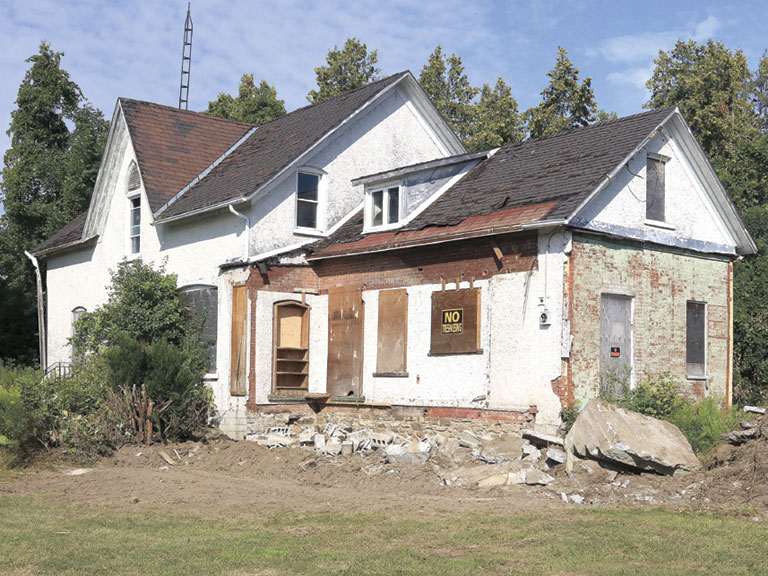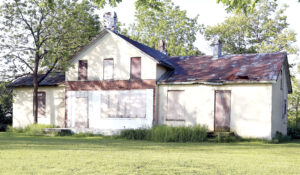County News
Heritage

Fate of two deteriorating properties still up in air
When the Prince Edward Heritage Advisory Committee met virtually last Thursday, the agenda included an update on the proposed demolition of two heritage properties located within Sandbanks Provincial Park. Prince Edward County mayor Steve Ferguson noted the municipality is still awaiting a response from the provincial government, but said an acknowledgement to the municipality’s recent correspondence had been received on April 2, 2020. On March 11, 2020, Mayor Ferguson sent a letter to Jeff Yurek, Minister of the Environment, Conservation and Parks, “Strongly encouraging the review of alternate options to the demolition of two heritage buildings within the park, and to seek a path respecting the Sandbanks Provincial Park Management Plan, which originally recognized the heritage value of the buildings proposed to be demolished.”
The letter refers to submitted comments made by the Heritage Advisory Committee to the Environmental Registry of Ontario on the proposal to amend the Sandbanks Provincial Park Management Plan to enable the demolition of two heritage properties, namely the Hyatt and MacDonald houses. The letter stated, “The Committee’s submission suggests the Mac- Donald and Hyatt properties present a unique opportunity to restore and re-purpose heritage assets.” Further it noted, “Demolishing the houses disregards and overlooks the community’s steadfast and consistent commitment to heritage.”
The Hyatt house (known later as Lakeview Lodge or the Gray House) is the older of the two properties in question, built in 1869 by James MacDonald Hyatt. It was purchased in 1972 by the Ministry of Natural Resources. The MacDonald house was constructed in 1878. Both former residences situated on County Road 12 have sat empty for at least 20 years and are now in poor condition. Heritage Advisory Committee member and Hiller ward councillor Ernie Margetson confirms both properties have deteriorated significantly. “In my opinion, based on my experience, the deterioration is reversible,” he says.

The 1869 Hyatt house slated for demolition is located within Sandbanks Provincial Park.
Providing some background subsequent to the meeting, Margetson explained how a 1993 Management Plan for Sandbanks Provincial Park committed to preserving buildings within the historical zone. Margetson refers to the historical zone as the cultural landscape between what was formally the Outlet Provincial Park and the Sandbanks Provincial Park. “There were farms and resorts in between those two parks and then they amalgamated the parks and that land over with some kind of an agreement with the landowners,” explained Margetson. “They identified the management of heritage resources as a significant issue and they said they would develop a Cultural Resources Management Plan which included these two houses.” He further noted that Sandbanks Provincial Park said any deterioration would be arrested and the potential for restoration, adaptive re-use and interpretation would be examined as part of the management plan they were going to develop.
In January 2020, the Heritage Advisory Committee submitted extensive comments to the Environmental Registry of Ontario on the proposal to amend the Sandbanks Provincial Park Management Plan to enable the demolition of two heritage properties, the MacDonald and Hyatt houses. It came after a December 2019 site visit to the two properties by Heritage Advisory Committee members and Robin Reilly, Park Superintendent.
Margetson made the point in that over 25 years, Sandbanks Provincial Park has not made a Cultural Resources Management Plan. “Due to their neglect, meaning their lack of maintenance and attention to these houses, they are now getting to the point of saying we need to demolish them for public safety,” he says. “Basically, they got to the point of demolition by neglecting them, which is always a risk with heritage buildings; you don’t do anything and then you get to the point where they are so bad they say it is not worth doing anything,” he adds. “It’s embarrassing for the province and Sandbanks Provincial Park specifically that they have got to this point; the homes were identified and they have just neglected them. They didn’t really follow through on their commitment, so we asked them to develop this Cultural Resource Management Plan before any decision was made to demolish these houses, so we are saying do what you said you were going to do in the first place.” As publicly owned heritage assets, Margetson says that the people of Ontario really own these properties.
If the homes can be saved, there are several potential options available, notes Margetson, although it’s unlikely they would be sold outright to the public because they sit on provincially owned Park land. Margetson doesn’t rule out a private-public partnership, suggesting that someone may want to take on the restoration with a long-term lease for example, but admits any type of arrangement gets complicated for government and takes time to administer. He says different criteria need to be looked at, such as the cost benefit, timelines and analysis, but adds people want to use the buildings. “They don’t have a visitors centre for instance, they are lacking office space, so they need to think outside the box,” he says. “Instead of tearing something down and building new, maybe they can use this as a front piece for a bigger building, something that has been suggested.” While the next Heritage Advisory Committee meeting is scheduled for July 16, an answer from the Minister is not anticipated by that meeting, with Margetson not expecting much action before the end of the year.

Comments (0)